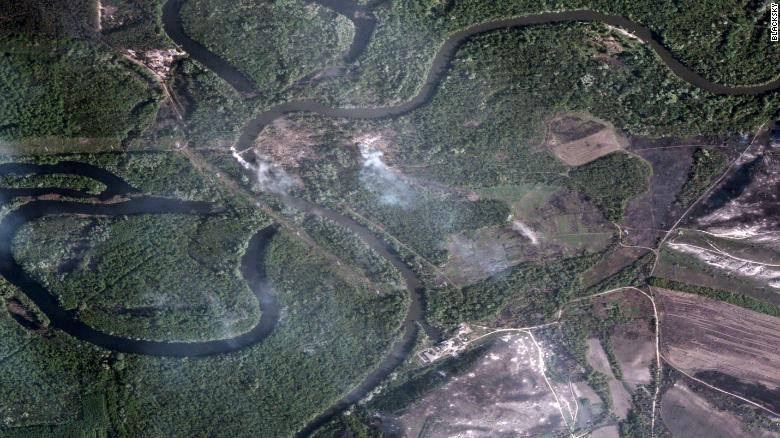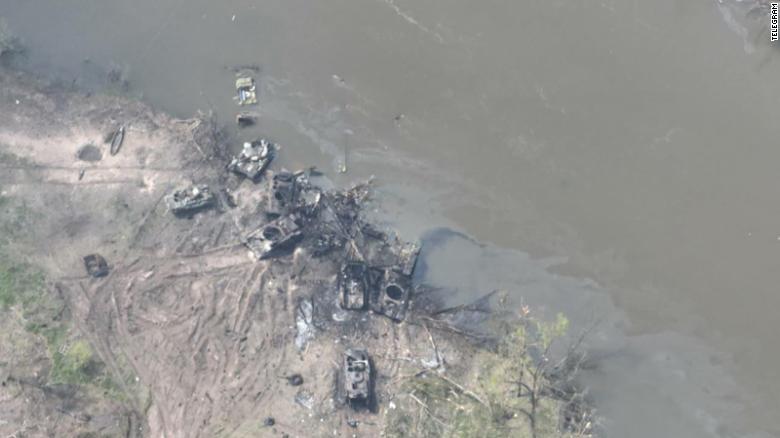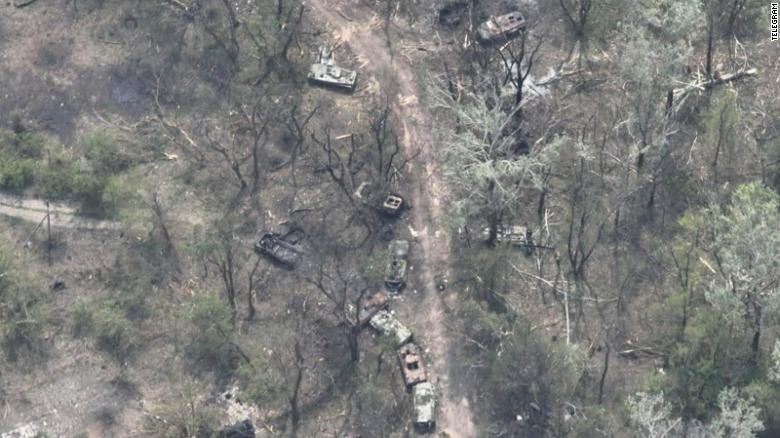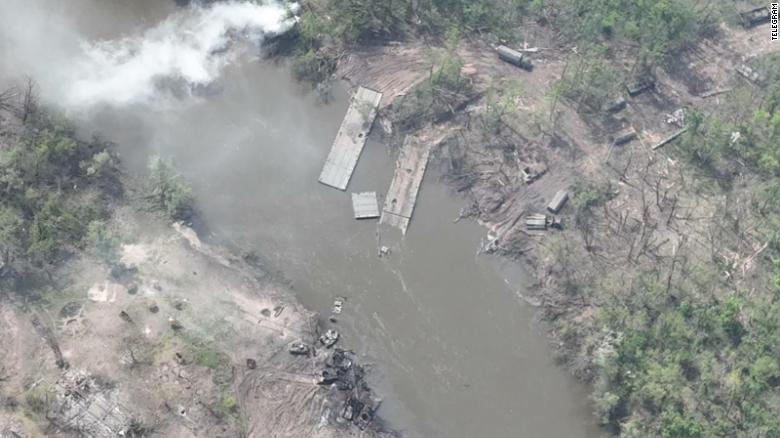The war in Ukraine will soon be three months old. Russia’s forces are still well short of the minimum objectives set out by President Vladimir Putin and in many areas the front lines are beginning to look static. But after weeks of intense bombardment, the Ukrainians’ defensive lines in the east are also degraded.
Essentially, two battlegrounds are emerging. The Russians are adding combat power to their drive to take the Luhansk and Donetsk regions. The Ukrainians are trying both to hold them back and to cut them off. It’s a three-dimensional chessboard of military calculation. And the natural boundaries shaped by one river in eastern Ukraine are already affecting the progress of each side.
Russian forces have taken territory — but in modest amounts. Many of their gains, especially in the south, came in the early days of the invasion, and they have tried to consolidate those. At the epicenter of the conflict — in the industrial belt of Luhansk region — they have resorted to blanket bombardment.
As one Ukrainian official put it: “The Russians do not change tactics: They destroy cities and only then enter the scorched earth.”
Russian ground forces are — for now — taking no more than incremental territory, while anecdotal reports speak of poor discipline and morale among some units.
Russia still has just under 100 battalion tactical groups (BTGs) in Ukraine, according to US officials, and another 20 just over the border. Each BTG has about 1,000 soldiers, but US officials assess that many have been degraded by more than two months of conflict.
In Luhansk and Donetsk — the goals of Russia’s “special military operation'”– no city has yet fallen into Russian control beyond Mariupol. That may be about to change after weeks of remorseless shelling of the industrial belt of Luhansk, a string of towns that includes Severodonetsk and Rubizhne. It now seems that Ukrainian resistance in Rubizhne is effectively over. Left behind is a landscape of rubble, without water, power or people.
Its occupiers — mainly Chechen fighters and the militia of the self-declared Luhansk People’s Republic — inherit a wasteland. But the loss of Rubizhne does make neighboring Severodonetsk, which was a city of 100,000 people before the invasion and where 15,000 now cower in basements, more vulnerable. And if Ukrainian resistance there is no longer tenable, new defensive lines will be needed to impede a Russian advance westwards.
However, the Russian offensive from the north has been much less successful. Which is where the meandering Siverskyi Donets comes into play. The river starts in Russia and flows into Ukraine, forming swamps, floodplains and oxbow lakes, cutting through chalk cliffs as it goes. In other words: a nightmare for a military assault.
The Russians have tried and apparently failed to put several pontoons across the river in an effort to encircle Ukrainian troops. Satellite imagery analyzed by CNN shows at least three bridges were destroyed this week and the Russians sustained heavy losses.
Further west, the Russians do appear to have crossed the river — but it’s too early to tell if that’s in sustainable and sufficient numbers. In the last month, since occupying Izium, they have made only limited progress despite the stretched Ukrainian lines. And their strategic goal — Sloviansk — has defenses in depth.


To sustain an offensive in this area, the Russian military needs supplies, and they must come from across the border. The supply line runs from Belgorod to the Ukrainian rail hub of Kupiansk and further south.
Ukrainian forces seem determined to disrupt this funnel and have made progress in retaking territory to the north and east of Kharkiv. In the first instance, this has reduced Russian fire on the city itself. And in some places Ukrainian units are now in sight of the Russian border, and have Russian supply lines within artillery range.
Video geolocated by CNN showed that several top-of-the-line Russian T90M tanks were destroyed as Ukrainian units pushed east towards the Siverskyi Donets. They now control the town of Staryi Saltiv, according to a CNN team that was in the deserted town Thursday.
Again the river is a natural obstacle — and in this area it might hamper further Ukrainian progress. But the Ukrainian counter-offensive has already led the Russians to pull some units back to protect their western flank and hold as many as 20 BTGs back in Belgorod.
As Mick Ryan, a former US major general puts it, the Ukrainians “have placed Russia commanders upon the ‘horns of a dilemma’ as they slowly deplete their combat power in the east.”
But Ryan doesn’t expect a more ambitious Ukrainian offensive, which would sap already stretched resources. “The Ukrainians will probably continue their continuous ‘nibbling away’ at the Russians to seize back their territory, rather than a general offensive on all fronts,” he tweeted.


The south: A very different war
The picture is less dynamic in the south, where the front lines have moved little. The Russians still control a substantial belt of farmland in Kherson and Zaporizhzhia regions, but their efforts to move further north have been sporadic.
In Kherson, for example, public unrest has subsided — partly because an estimated 45% of the region’s population is reported to have left.
The Russians continue to launch cruise missile attacks on Odesa and other coastal regions, without much purpose beyond terrorizing the civilian population and with little “operational design” in military language.
Any effort to attack the city from land or sea seems very implausible, especially since the sinking of Russia’s guided-missile cruiser, the Moskva.
US intelligence discounts any imminent prospect that Russian forces would try to seize all of Ukraine’s coast. That would likely require a full mobilization inside Russia, a step Putin has so far not ordered.
Instead, the Russians seems intent on consolidating their control over a land corridor running from the border to Crimea and trying to “integrate” Kherson into the “Russian world” by introducing Russian passports, the ruble and a puppet administration.
But their proxies are ruling over areas in grim conditions, with healthcare and utilities severely impaired. And there is plenty of evidence that Russian units are treating the region as a candy store, stealing everything from tractors to museum artifacts. As yet there is no serious effort at governing.

A war of attrition
Few expect a knock-out blow by either side in the coming months. A war of attrition looks more likely as the weapons supplied by the US and its allies tilt the balance on the battlefield. The first American howitzers on now on the front lines.
The US Director of National Intelligence, Avril Haines, said this week that “as both Russia and Ukraine believe they can continue to make progress militarily, we do not see a viable negotiating path forward, at least in the short term.”
“The uncertain nature of the battle, which is developing into a war of attrition, combined with the reality that Putin faces a mismatch between his ambitions and Russia’s current conventional military capabilities, likely means the next few months could see us moving along a more unpredictable and potentially escalatory trajectory.”
Perhaps the greatest risk for Ukraine is that a war like this — along essentially the same fronts that we see today — would be sustainable, if tough, for Russia. However, it would hammer the Ukrainian economy, which is already expected to shrink by 45% this year, according to the World Bank.
Putin could then wait for an opportunity to take a further bite out of a country that he believes has no right to exist.
There is the additional risk — if not yet evident — that the West’s sense of urgency in backing Ukraine with cash and weapons might wane should the conflict settle into stagnation. Remember Syria.
But the course of Russia’s invasion of Ukraine has already defied most expectations. The time is approaching when critical decisions — or mistakes — by either side may well influence its outcome.
In the words of the Chinese strategist Sun Tzu: “The opportunity to secure ourselves against defeat lies in our own hands, but the opportunity of defeating the enemy is provided by the enemy himself.”
As reported by CNN
